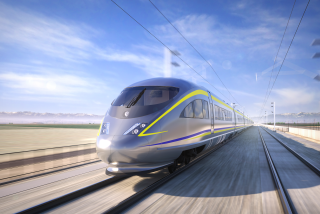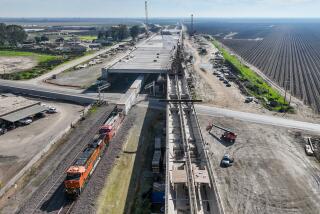L.A. leaders back revised bullet-train business plan
- Share via
Several Los Angeles leaders backed a revised business plan released Monday by the agency overseeing California’s ambitious high-speed rail effort, saying it lowers costs and speeds construction while bringing jobs and world-class transit to the region.
By embracing a “blended” approach, the plan shaves $30 billion off the cost by using some tracks that now carry regional passenger lines rather than building new ones exclusively for the bullet train.
“High-speed rail is the natural extension of the transportation network we are building in Southern California,” said L.A. Mayor Antonio Villaraigosa. “When it comes to transportation infrastructure, connectivity is key.”
If the plan is approved, construction would begin this year on a 300-mile stretch of electrified rail connecting Merced in the Central Valley to the San Fernando Valley within 10 years. An earlier draft included only a 130-mile portion of that.
Eventually, the line would extend from Southern California, through several cities in the Central Valley, to the Bay Area.
Even with the $30-billion reduction, the projected $68.4-billion effort is $25 billion more than the original price tag.
Officials with the California High-Speed Rail Authority said Monday that construction of the entire 520-mile system would be completed in 2028. It would open to the public in 2029.
Supporters of the revised plan included Gary Toebben, president of the Los Angeles Area Chamber of Commerce, and union groups that have long backed building a high-speed rail system because of the jobs it would provide.
“This plan will propel the high-speed rail project forward while going back to basics — let’s put people to work to build much-needed transportation networks, and let’s do it fast,” said Robbie Hunter of the Los Angeles/Orange Counties Building & Construction Trades Council.
Other related measures the authority is proposing call for about $2 billion to upgrade existing rail lines into Los Angeles and the Bay Area.
But some critics say the proposed system is not the one voters were promised when they approved $9 billion to get the project started four years ago.
“This looks nothing like what the people of California were promised in 2008, when the rail authority claimed that tickets would cost $50, Sacramento and San Diego would be included and the private sector would fund much of the project,” said state Sen. Doug LaMalfa (R-Richvale).
“This is one bait-and-switch that cash-strapped Californians simply can’t afford,” he said.
One of the project’s initial proponents took issue with plans to share tracks with commuter trains.
“I call it the great train robbery,” said Quentin Kopp, a former state senator and rail authority board member. “Because they plan, if they can get away with it, to take money out of high-speed rail and bestow it on to commuter rail systems,” he said.
“This isn’t high-speed rail,” Kopp said, “High-speed rail runs on dedicated tracks.”
More to Read
Sign up for Essential California
The most important California stories and recommendations in your inbox every morning.
You may occasionally receive promotional content from the Los Angeles Times.













